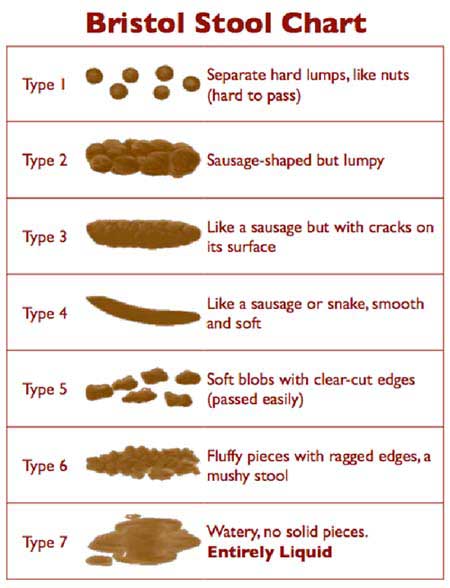What is Normal Stool?
Your stool is about 75 percent water. The rest is a fetid combination of fiber, live and dead bacteria, miscellaneous cells and mucus. The characteristics of your stool will tell you a good deal about how happy and healthy your digestive tract is – the color, odor, shape, size, and even the sound it makes when it hits the water and whether it’s a “sinker” or a “floater” are all relevant information.If you’re one to poop and scoot quickly out of the bathroom without looking in the toilet, you might want to slow down and look down. The Bristol Stool Chart is a handy tool that may help you learn what you’re going for. Ideally, your stool should approximate Types 3, 4 and 5, “like a sausage or a snake, smooth and soft” to “soft blobs that pass easily.” Type 4 is the Holy Grail.Fiber tends to bulk up your stool and acts like glue to keep the stool stuck together, instead of in pieces. If your stool is on the softer side, short of diarrhea (“soft serve,” as some call it), it could be related to lactose intolerance, artificial sweeteners (sorbitol and Splenda), or a reaction to fructose or gluten.
Look, Listen and Smell Before You Flush
What’s normal and what’s not when you look into the toilet? The following table will help you narrow down what to look for, so that you aren’t needlessly alarmed. Of course, there are a few signs that ARE cause for concern. If you have a change in stools accompanied by abdominal pain, please report this to your physician.
Healthy Stool Unhealthy Stool Medium to light brown Stool that is hard to pass, painful, or requires straining Smooth and soft, formed into one long shape and not a bunch of pieces Hard lumps and pieces, or mushy and watery, or even pasty and difficult to clean off About one to two inches in diameter and up to 18 inches long Narrow, pencil-like or ribbon-like stools: can indicate a bowel obstruction or tumor – or worst case, colon cancer; narrow stools on an infrequent basis are not so concerning, but if they persist, definitely warrant a call to your physician5 S-shaped, which comes from the shape of your lower intestine6 Black, tarry stools or bright red stoolsmay indicate bleeding in the GI tract; black stools can also come from certain medications, supplements or consuming black licorice; if you have black, tarry stools, it’s best to be evaluated by your healthcare provider Quiet and gentle dive into the water...it should fall into the bowl with the slightest little “whoosh” sound – not a loud, wet cannonball splash that leaves your toosh in need of a shower White, pale or gray stools may indicate a lack of bile, which may suggest a serious problem (hepatitis, cirrhosis, pancreatic disorders, or possibly a blocked bile duct), so this warrants a call to your physician; antacids may also produce white stool Natural smell, not repulsive (I’m not saying it will smell good) Yellow stools may indicate giardia infection, a gallbladder problem, or a condition known as Gilbert’s syndrome – if you see this, call your doctor Uniform texture Presence of undigested food (more of a concern if accompanied by diarrhea, weight loss, or other changes in bowel habits) Sinks slowly Floaters or splashers Increased mucus in stool: This can be associated with inflammatory bowel disease like Crohn’s disease, or ulcerative colitis, or even colon cancer, especially if accompanied by blood or abdominal pain
Does Your Stool Have a Really Bad Odor?
Speaking of malodorous things, what about gas? Passing gas is normal. Not only is it normal, it’s a good sign that trillions of hard working gut bacteria are doing their jobs. People pass gas an average 14 times per day – anywhere from one to four pints of it!8 Ninety nine percent of gas is odorless, so you may even be unaware you’re passing it. Think about it – were it not for an exit, we’d all blow up like balloons!If your stool has an extraordinarily bad odor, it should not be ignored. This mean an odor above and beyond the normally objectionable stool odor. Stinky stool can be associated with a number of health problems, such as:
- A malabsorptive disorder
- Celiac disease
- Crohn’s disease
- Chronic pancreatitis
- Cystic fibrosis
Cystic fibrosis (CF) is a disease caused by a defective gene that causes your body to produce abnormally thick, sticky mucus, which builds up and causes life-threatening lung infections and serious digestive problems. Most cases of CF are diagnosed before the age of 2, so this is more of a concern with infants and toddlers.
~excerpted from Dr. Mercola

No comments:
Post a Comment